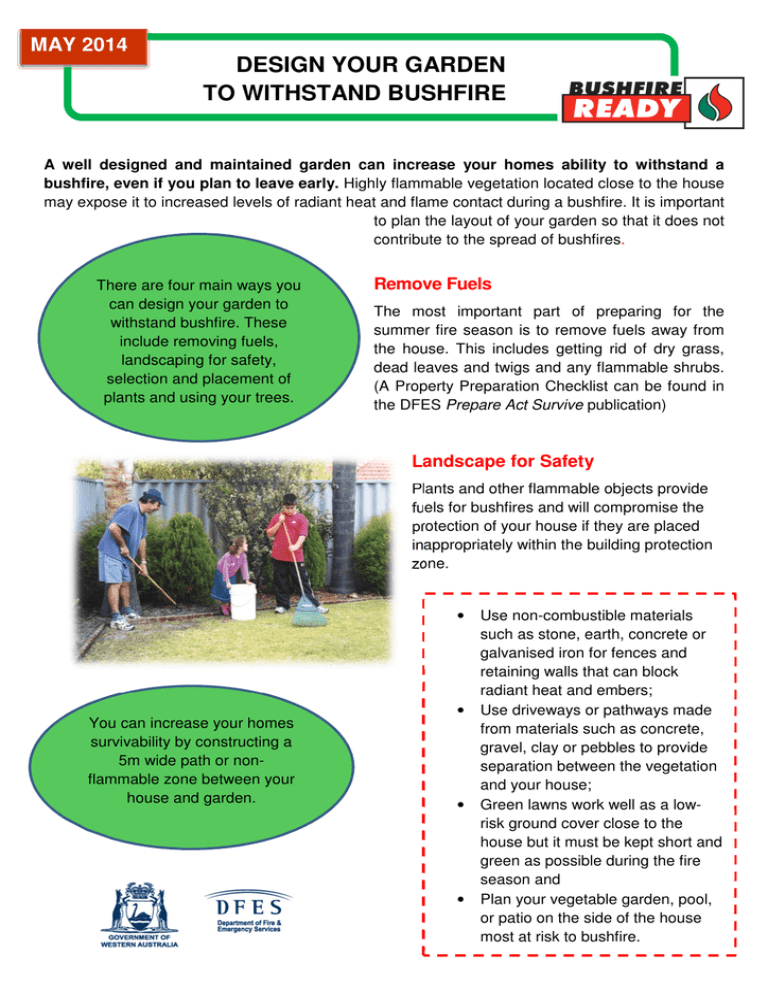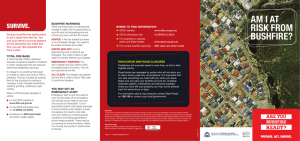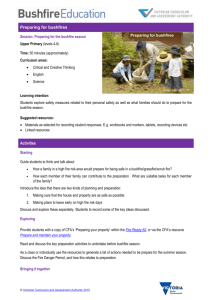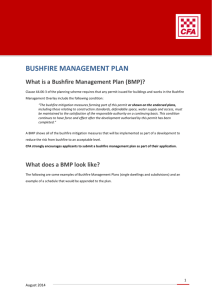DESIGN YOUR GARDEN TO WITHSTAND BUSHFIRE
advertisement

MAY 2014 2014 DESIGN YOUR GARDEN TO WITHSTAND BUSHFIRE A well designed and maintained garden can increase your homes ability to withstand a bushfire, even if you plan to leave early. Highly flammable vegetation located close to the house may expose it to increased levels of radiant heat and flame contact during a bushfire. It is important to plan the layout of your garden so that it does not contribute to the spread of bushfires. There are four main ways you can design your garden to withstand bushfire. These include removing fuels, landscaping for safety, selection and placement of plants and using your trees. Remove Fuels The most important part of preparing for the summer fire season is to remove fuels away from the house. This includes getting rid of dry grass, dead leaves and twigs and any flammable shrubs. (A Property Preparation Checklist can be found in the DFES Prepare Act Survive publication) Landscape for Safety Plants and other flammable objects provide fuels for bushfires and will compromise the protection of your house if they are placed inappropriately within the building protection zone. • You can increase your homes survivability by constructing a 5m wide path or nonflammable zone between your house and garden. • • • Use non-combustible materials such as stone, earth, concrete or galvanised iron for fences and retaining walls that can block radiant heat and embers; Use driveways or pathways made from materials such as concrete, gravel, clay or pebbles to provide separation between the vegetation and your house; Green lawns work well as a lowrisk ground cover close to the house but it must be kept short and green as possible during the fire season and Plan your vegetable garden, pool, or patio on the side of the house most at risk to bushfire. Selection and Placement of Plants Although all plants will burn under the right conditions, low flammability plants may actually help to protect your home by: • • • • Shielding your house from strong winds; Catching burning embers before they reach your house; Reducing radiant heat levels; and Reducing the likelihood of direct flame contact. Plant spacing Fires spread more easily when plants are located close together because the radiant heat will dry out surrounding vegetation enough for it to catch alight. A garden with continuous vegetation, particularly fine fuels, leading up to and surrounding the house will allow fire to spread from the garden to the house, placing the house at greater risk of catching alight. DFES strongly encourages home Plant species owners to contact Some plants will burn easily and quickly while others may their local nursery provide better protection for your home. Those that provide for advice on the best protection in a fire contain plenty of water or salt in appropriate plant their leaves, don’t contain volatile oils and have no dead characteristics leaves and twigs within their crown. It is also important that the plants do not become a weed problem following the fire disturbance. Use Your Trees Trees can be useful in a bushfire provided they are; carefully selected, properly maintained, and located at a safe distance from the house. In a hot dry summer, trees are likely to be the greenest and wettest things around but they may still become flammable under drought conditions. Using appropriately placed trees as a wind break can: reduce wind speed, absorb radiant heat, and filter burning embers. You want your trees to carry the hot fire laden winds up and over your house, but you don’t want them to catch fire. If they do catch alight, you don’t want them to spread the fire to other trees or your house. For further information on this topic: The Homeowners Bushfire Survival Manual http://www.dfes.wa.gov.au/safetyinformation/fire/bushfire/BushfireManualsandGuides/FESA_BushfireHomeowners_Survival_Manual.pdf Prepare Act Survive Publication http://www.dfes.wa.gov.au/safetyinformation/fire/bushfire/BushfireManualsandGuides/DFES_BushfirePrepare_Act_Survive_Booklet.pdf Plant Guide within the Building Protection Zone for the Swan Coast http:/www.dfes.wa.gov.au/safetyinformation/fire/bushfire/BushfireProtectionPlanningPublications/FESA%2 0Plant%20Guide-BP%20Zone-Final-w.pdf For technical information contact the Environmental Protection Branch at environment@dfes.wa.gov.au or Community Engagement on 9395 9816 / communitysafetyresources@dfes.wa.gov.au




